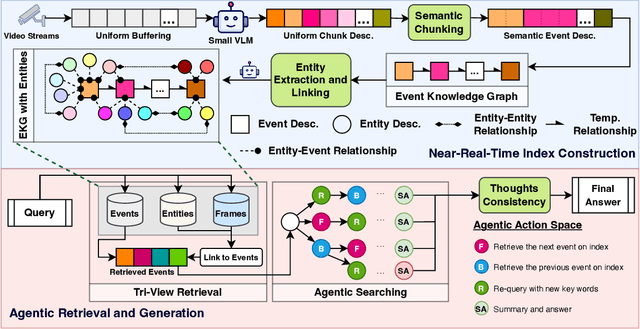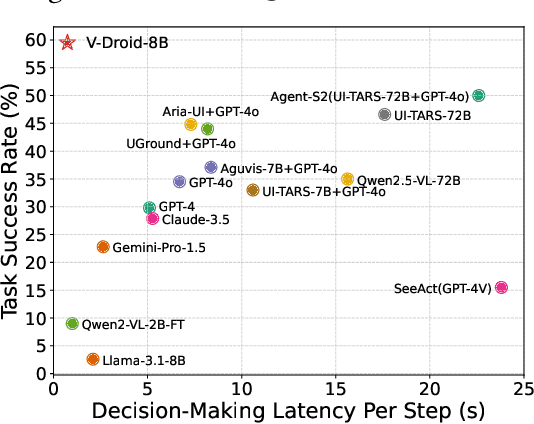Ting Cao
Microsoft Research
Sculptor: Empowering LLMs with Cognitive Agency via Active Context Management
Aug 06, 2025Abstract:Large Language Models (LLMs) suffer from significant performance degradation when processing long contexts due to proactive interference, where irrelevant information in earlier parts of the context disrupts reasoning and memory recall. While most research focuses on external memory systems to augment LLMs' capabilities, we propose a complementary approach: empowering LLMs with Active Context Management (ACM) tools to actively sculpt their internal working memory. We introduce Sculptor, a framework that equips LLMs with three categories of tools: (1) context fragmentation, (2) summary, hide, and restore, and (3) intelligent search. Our approach enables LLMs to proactively manage their attention and working memory, analogous to how humans selectively focus on relevant information while filtering out distractions. Experimental evaluation on information-sparse benchmarks-PI-LLM (proactive interference) and NeedleBench Multi-Needle Reasoning-demonstrates that Sculptor significantly improves performance even without specific training, leveraging LLMs' inherent tool calling generalization capabilities. By enabling Active Context Management, Sculptor not only mitigates proactive interference but also provides a cognitive foundation for more reliable reasoning across diverse long-context tasks-highlighting that explicit context-control strategies, rather than merely larger token windows, are key to robustness at scale.
SeerAttention-R: Sparse Attention Adaptation for Long Reasoning
Jun 10, 2025



Abstract:We introduce SeerAttention-R, a sparse attention framework specifically tailored for the long decoding of reasoning models. Extended from SeerAttention, SeerAttention-R retains the design of learning attention sparsity through a self-distilled gating mechanism, while removing query pooling to accommodate auto-regressive decoding. With a lightweight plug-in gating, SeerAttention-R is flexible and can be easily integrated into existing pretrained model without modifying the original parameters. We demonstrate that SeerAttention-R, trained on just 0.4B tokens, maintains near-lossless reasoning accuracy with 4K token budget in AIME benchmark under large sparse attention block sizes (64/128). Using TileLang, we develop a highly optimized sparse decoding kernel that achieves near-theoretical speedups of up to 9x over FlashAttention-3 on H100 GPU at 90% sparsity. Code is available at: https://github.com/microsoft/SeerAttention.
SwarmThinkers: Learning Physically Consistent Atomic KMC Transitions at Scale
May 26, 2025Abstract:Can a scientific simulation system be physically consistent, interpretable by design, and scalable across regimes--all at once? Despite decades of progress, this trifecta remains elusive. Classical methods like Kinetic Monte Carlo ensure thermodynamic accuracy but scale poorly; learning-based methods offer efficiency but often sacrifice physical consistency and interpretability. We present SwarmThinkers, a reinforcement learning framework that recasts atomic-scale simulation as a physically grounded swarm intelligence system. Each diffusing particle is modeled as a local decision-making agent that selects transitions via a shared policy network trained under thermodynamic constraints. A reweighting mechanism fuses learned preferences with transition rates, preserving statistical fidelity while enabling interpretable, step-wise decision making. Training follows a centralized-training, decentralized-execution paradigm, allowing the policy to generalize across system sizes, concentrations, and temperatures without retraining. On a benchmark simulating radiation-induced Fe-Cu alloy precipitation, SwarmThinkers is the first system to achieve full-scale, physically consistent simulation on a single A100 GPU, previously attainable only via OpenKMC on a supercomputer. It delivers up to 4963x (3185x on average) faster computation with 485x lower memory usage. By treating particles as decision-makers, not passive samplers, SwarmThinkers marks a paradigm shift in scientific simulation--one that unifies physical consistency, interpretability, and scalability through agent-driven intelligence.
Empowering Agentic Video Analytics Systems with Video Language Models
May 02, 2025



Abstract:AI-driven video analytics has become increasingly pivotal across diverse domains. However, existing systems are often constrained to specific, predefined tasks, limiting their adaptability in open-ended analytical scenarios. The recent emergence of Video-Language Models (VLMs) as transformative technologies offers significant potential for enabling open-ended video understanding, reasoning, and analytics. Nevertheless, their limited context windows present challenges when processing ultra-long video content, which is prevalent in real-world applications. To address this, we introduce AVAS, a VLM-powered system designed for open-ended, advanced video analytics. AVAS incorporates two key innovations: (1) the near real-time construction of Event Knowledge Graphs (EKGs) for efficient indexing of long or continuous video streams, and (2) an agentic retrieval-generation mechanism that leverages EKGs to handle complex and diverse queries. Comprehensive evaluations on public benchmarks, LVBench and VideoMME-Long, demonstrate that AVAS achieves state-of-the-art performance, attaining 62.3% and 64.1% accuracy, respectively, significantly surpassing existing VLM and video Retrieval-Augmented Generation (RAG) systems. Furthermore, to evaluate video analytics in ultra-long and open-world video scenarios, we introduce a new benchmark, AVAS-100. This benchmark comprises 8 videos, each exceeding 10 hours in duration, along with 120 manually annotated, diverse, and complex question-answer pairs. On AVAS-100, AVAS achieves top-tier performance with an accuracy of 75.8%.
Zoomer: Adaptive Image Focus Optimization for Black-box MLLM
Apr 30, 2025



Abstract:Recent advancements in multimodal large language models (MLLMs) have broadened the scope of vision-language tasks, excelling in applications like image captioning and interactive question-answering. However, these models struggle with accurately processing visual data, particularly in tasks requiring precise object recognition and fine visual details. Stringent token limits often result in the omission of critical information, hampering performance. To address these limitations, we introduce \SysName, a novel visual prompting mechanism designed to enhance MLLM performance while preserving essential visual details within token limits. \SysName features three key innovations: a prompt-aware strategy that dynamically highlights relevant image regions, a spatial-preserving orchestration schema that maintains object integrity, and a budget-aware prompting method that balances global context with crucial visual details. Comprehensive evaluations across multiple datasets demonstrate that \SysName consistently outperforms baseline methods, achieving up to a $26.9\%$ improvement in accuracy while significantly reducing token consumption.
Scaling Up On-Device LLMs via Active-Weight Swapping Between DRAM and Flash
Apr 11, 2025Abstract:Large language models (LLMs) are increasingly being deployed on mobile devices, but the limited DRAM capacity constrains the deployable model size. This paper introduces ActiveFlow, the first LLM inference framework that can achieve adaptive DRAM usage for modern LLMs (not ReLU-based), enabling the scaling up of deployable model sizes. The framework is based on the novel concept of active weight DRAM-flash swapping and incorporates three novel techniques: (1) Cross-layer active weights preloading. It uses the activations from the current layer to predict the active weights of several subsequent layers, enabling computation and data loading to overlap, as well as facilitating large I/O transfers. (2) Sparsity-aware self-distillation. It adjusts the active weights to align with the dense-model output distribution, compensating for approximations introduced by contextual sparsity. (3) Active weight DRAM-flash swapping pipeline. It orchestrates the DRAM space allocation among the hot weight cache, preloaded active weights, and computation-involved weights based on available memory. Results show ActiveFlow achieves the performance-cost Pareto frontier compared to existing efficiency optimization methods.
BitDecoding: Unlocking Tensor Cores for Long-Context LLMs Decoding with Low-Bit KV Cache
Mar 24, 2025Abstract:The growing adoption of long-context Large Language Models (LLMs) has introduced significant memory and computational challenges in autoregressive decoding due to the expanding Key-Value (KV) cache. KV cache quantization has emerged as a promising solution, with prior work showing that 4-bit or even 2-bit quantization can maintain model accuracy while reducing memory costs. However, despite these benefits, preliminary implementations for the low-bit KV cache struggle to deliver the expected speedup due to quantization and dequantization overheads and the lack of Tensor Cores utilization. In this work, we propose BitDecoding, a GPU-optimized framework that unlocks Tensor Cores for efficient decoding with low-bit KV cache. Efficiently leveraging Tensor Cores for low-bit KV cache is challenging due to the dynamic nature of KV cache generation at each decoding step. BitDecoding addresses these challenges with a Tensor Cores-Centric BitFusion Scheme that ensures data layout compatibility to enable high utilization of Tensor Cores. Additionally, BitDecoding incorporates a warp-efficient parallel decoding kernel and a fine-grained asynchronous pipeline, minimizing dequantization overhead and improving computational efficiency. Experiments show that BitDecoding achieves up to 7.5x speedup on RTX 4090, 4.8x on A100, and 8.9x on H100, compared to FP16 FlashDecoding-v2. It also outperforms the state-of-the-art low-bit KV cache implementation (QServe) by up to 4.3x. On LLaMA-3.1-8B with a 128K sequence length, BitDecoding reduces single-batch decoding latency by 3x, demonstrating its effectiveness in long-context generation scenarios. The code is available at https://github.com/DD-DuDa/BitDecoding.
Advancing Mobile GUI Agents: A Verifier-Driven Approach to Practical Deployment
Mar 21, 2025



Abstract:We propose V-Droid, a mobile GUI task automation agent. Unlike previous mobile agents that utilize Large Language Models (LLMs) as generators to directly generate actions at each step, V-Droid employs LLMs as verifiers to evaluate candidate actions before making final decisions. To realize this novel paradigm, we introduce a comprehensive framework for constructing verifier-driven mobile agents: the discretized action space construction coupled with the prefilling-only workflow to accelerate the verification process, the pair-wise progress preference training to significantly enhance the verifier's decision-making capabilities, and the scalable human-agent joint annotation scheme to efficiently collect the necessary data at scale. V-Droid sets a new state-of-the-art task success rate across several public mobile task automation benchmarks: 59.5% on AndroidWorld, 38.3% on AndroidLab, and 49% on MobileAgentBench, surpassing existing agents by 9.5%, 2.1%, and 9%, respectively. Furthermore, V-Droid achieves an impressively low latency of 0.7 seconds per step, making it the first mobile agent capable of delivering near-real-time, effective decision-making capabilities.
StreamMind: Unlocking Full Frame Rate Streaming Video Dialogue through Event-Gated Cognition
Mar 08, 2025Abstract:With the rise of real-world human-AI interaction applications, such as AI assistants, the need for Streaming Video Dialogue is critical. To address this need, we introduce \sys, a video LLM framework that achieves ultra-FPS streaming video processing (100 fps on a single A100) and enables proactive, always-on responses in real time, without explicit user intervention. To solve the key challenge of the contradiction between linear video streaming speed and quadratic transformer computation cost, we propose a novel perception-cognition interleaving paradigm named ''event-gated LLM invocation'', in contrast to the existing per-time-step LLM invocation. By introducing a Cognition Gate network between the video encoder and the LLM, LLM is only invoked when relevant events occur. To realize the event feature extraction with constant cost, we propose Event-Preserving Feature Extractor (EPFE) based on state-space method, generating a single perception token for spatiotemporal features. These techniques enable the video LLM with full-FPS perception and real-time cognition response. Experiments on Ego4D and SoccerNet streaming tasks, as well as standard offline benchmarks, demonstrate state-of-the-art performance in both model capability and real-time efficiency, paving the way for ultra-high-FPS applications, such as Game AI Copilot and interactive media.
Bitnet.cpp: Efficient Edge Inference for Ternary LLMs
Feb 17, 2025Abstract:The advent of 1-bit large language models (LLMs), led by BitNet b1.58, has spurred interest in ternary LLMs. Despite this, research and practical applications focusing on efficient edge inference for ternary LLMs remain scarce. To bridge this gap, we introduce Bitnet.cpp, an inference system optimized for BitNet b1.58 and ternary LLMs. Given that mixed-precision matrix multiplication (mpGEMM) constitutes the bulk of inference time in ternary LLMs, Bitnet.cpp incorporates a novel mpGEMM library to facilitate sub-2-bits-per-weight, efficient and lossless inference. The library features two core solutions: Ternary Lookup Table (TL), which addresses spatial inefficiencies of previous bit-wise methods, and Int2 with a Scale (I2_S), which ensures lossless edge inference, both enabling high-speed inference. Our experiments show that Bitnet.cpp achieves up to a 6.25x increase in speed over full-precision baselines and up to 2.32x over low-bit baselines, setting new benchmarks in the field. Additionally, we expand TL to element-wise lookup table (ELUT) for low-bit LLMs in the appendix, presenting both theoretical and empirical evidence of its considerable potential. Bitnet.cpp is publicly available at https://github.com/microsoft/BitNet/tree/paper , offering a sophisticated solution for the efficient and practical deployment of edge LLMs.
 Add to Chrome
Add to Chrome Add to Firefox
Add to Firefox Add to Edge
Add to Edge